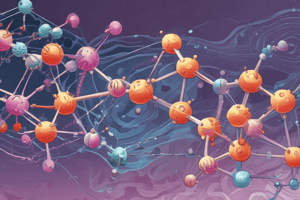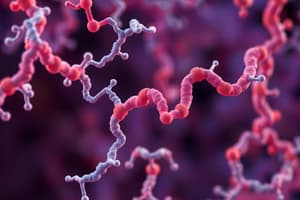Podcast
Questions and Answers
What is one of the main roles of protein phosphorylation in cellular signaling?
What is one of the main roles of protein phosphorylation in cellular signaling?
Which residues are involved in the process of protein phosphorylation?
Which residues are involved in the process of protein phosphorylation?
Which statement about structural domains is correct?
Which statement about structural domains is correct?
What is the significance of chemical modification in proteins?
What is the significance of chemical modification in proteins?
Signup and view all the answers
What does it mean for a structural domain to be described as modular?
What does it mean for a structural domain to be described as modular?
Signup and view all the answers
What is the primary function of receptor tyrosine kinases (RTKs)?
What is the primary function of receptor tyrosine kinases (RTKs)?
Signup and view all the answers
Which domains are specifically involved in binding oligopeptide motifs?
Which domains are specifically involved in binding oligopeptide motifs?
Signup and view all the answers
What role does PTEN play in cellular signaling?
What role does PTEN play in cellular signaling?
Signup and view all the answers
Which statement about Grb2 is true?
Which statement about Grb2 is true?
Signup and view all the answers
Which of the following motifs is involved in binding to phosphoinositides?
Which of the following motifs is involved in binding to phosphoinositides?
Signup and view all the answers
What is the characteristic feature of SH2 domains?
What is the characteristic feature of SH2 domains?
Signup and view all the answers
Which domains provide sites for interaction with other proteins but do not have enzymatic activity?
Which domains provide sites for interaction with other proteins but do not have enzymatic activity?
Signup and view all the answers
Which proteins are examples of those containing SH2 domains?
Which proteins are examples of those containing SH2 domains?
Signup and view all the answers
What is the main function of PDZ domains?
What is the main function of PDZ domains?
Signup and view all the answers
Which of the following motifs is involved in calcium binding?
Which of the following motifs is involved in calcium binding?
Signup and view all the answers
What do the first letters of the acronym PDZ stand for?
What do the first letters of the acronym PDZ stand for?
Signup and view all the answers
Which type of domains are considered to have intrinsic catalytic activity?
Which type of domains are considered to have intrinsic catalytic activity?
Signup and view all the answers
What happens in the signaling pathway activated by light in Drosophila photoreceptors?
What happens in the signaling pathway activated by light in Drosophila photoreceptors?
Signup and view all the answers
What does a loss of the InaD scaffold result in?
What does a loss of the InaD scaffold result in?
Signup and view all the answers
Which of the following is an example of a phosphoinositide-binding domain?
Which of the following is an example of a phosphoinositide-binding domain?
Signup and view all the answers
What is the purpose of the coupling of PKC to PLCβ via the InaD scaffold?
What is the purpose of the coupling of PKC to PLCβ via the InaD scaffold?
Signup and view all the answers
What is the primary role of a PDZ binding motif?
What is the primary role of a PDZ binding motif?
Signup and view all the answers
Which of the following statements is true about scaffold proteins?
Which of the following statements is true about scaffold proteins?
Signup and view all the answers
Which of the following is NOT a characteristic of MAGUK proteins?
Which of the following is NOT a characteristic of MAGUK proteins?
Signup and view all the answers
What type of proteins does the InaD protein function primarily with in fruit flies?
What type of proteins does the InaD protein function primarily with in fruit flies?
Signup and view all the answers
How does the PDZ domain interact within PDZ-based scaffold proteins?
How does the PDZ domain interact within PDZ-based scaffold proteins?
Signup and view all the answers
Which of the following correctly describes the domains found in MAGUK proteins?
Which of the following correctly describes the domains found in MAGUK proteins?
Signup and view all the answers
Which of the following proteins is a PDZ-based scaffold protein?
Which of the following proteins is a PDZ-based scaffold protein?
Signup and view all the answers
What is a key characteristic of proline-rich sequences recognized by SH3 domains?
What is a key characteristic of proline-rich sequences recognized by SH3 domains?
Signup and view all the answers
Which of the following statements best describes PDZ- and nonPDZ-based scaffold proteins?
Which of the following statements best describes PDZ- and nonPDZ-based scaffold proteins?
Signup and view all the answers
Which proteins are examples of those that contain SH3 domains?
Which proteins are examples of those that contain SH3 domains?
Signup and view all the answers
Which domain is known for binding phosphotyrosine residues?
Which domain is known for binding phosphotyrosine residues?
Signup and view all the answers
What is the physiological significance of PH domains?
What is the physiological significance of PH domains?
Signup and view all the answers
Which of the following statements is true regarding Src family kinases?
Which of the following statements is true regarding Src family kinases?
Signup and view all the answers
What ability do PTB domains have that is not shared with SH2 domains?
What ability do PTB domains have that is not shared with SH2 domains?
Signup and view all the answers
PH domains primarily bind to which type of ligands?
PH domains primarily bind to which type of ligands?
Signup and view all the answers
Which of the following best describes the structural characteristic of SH3 domains?
Which of the following best describes the structural characteristic of SH3 domains?
Signup and view all the answers
What type of structural motif is the EF-hand motif primarily associated with?
What type of structural motif is the EF-hand motif primarily associated with?
Signup and view all the answers
Which domain is characterized by its ability to bind phosphoinositides?
Which domain is characterized by its ability to bind phosphoinositides?
Signup and view all the answers
Which of the following domains is specifically recognized for binding oligopeptide motifs?
Which of the following domains is specifically recognized for binding oligopeptide motifs?
Signup and view all the answers
What is the structural arrangement of the GRK2 PH domain?
What is the structural arrangement of the GRK2 PH domain?
Signup and view all the answers
What type of ion do C2 domains primarily bind?
What type of ion do C2 domains primarily bind?
Signup and view all the answers
Which of the following correctly describes the coordination of the Ca2+ ion in calmodulin's EF-hand region?
Which of the following correctly describes the coordination of the Ca2+ ion in calmodulin's EF-hand region?
Signup and view all the answers
The C2H2 zinc finger domain is named due to the presence of which amino acids coordinating zinc?
The C2H2 zinc finger domain is named due to the presence of which amino acids coordinating zinc?
Signup and view all the answers
What characterizes the structure of PH domains?
What characterizes the structure of PH domains?
Signup and view all the answers
Flashcards
Protein Modules
Protein Modules
Specific regions within proteins that actively participate in recognition processes.
Protein Phosphorylation
Protein Phosphorylation
A common way for cells to transmit information by adding a phosphate group to a protein.
Protein Kinase
Protein Kinase
An enzyme that adds a phosphate group to a protein.
Structural Domains
Structural Domains
Signup and view all the flashcards
PTB and SH2 Domains
PTB and SH2 Domains
Signup and view all the flashcards
Receptor Tyrosine Kinases (RTKs)
Receptor Tyrosine Kinases (RTKs)
Signup and view all the flashcards
Tyrosine Kinase Domain
Tyrosine Kinase Domain
Signup and view all the flashcards
PTEN
PTEN
Signup and view all the flashcards
PIP2
PIP2
Signup and view all the flashcards
PIP3
PIP3
Signup and view all the flashcards
Protein Interaction Domains
Protein Interaction Domains
Signup and view all the flashcards
SH2 Domain
SH2 Domain
Signup and view all the flashcards
SH3 Domain
SH3 Domain
Signup and view all the flashcards
Proline-Rich Sequences
Proline-Rich Sequences
Signup and view all the flashcards
PhosphoTyrosine Binding Domains
PhosphoTyrosine Binding Domains
Signup and view all the flashcards
What are seven main phosphoinositides?
What are seven main phosphoinositides?
Signup and view all the flashcards
What are the major protein domains that bind to oligopeptide motifs?
What are the major protein domains that bind to oligopeptide motifs?
Signup and view all the flashcards
What are important factors that regulate protein localization to membranes?
What are important factors that regulate protein localization to membranes?
Signup and view all the flashcards
EF-hand Motif
EF-hand Motif
Signup and view all the flashcards
Calmodulin
Calmodulin
Signup and view all the flashcards
Zinc Finger Domain (C2H2)
Zinc Finger Domain (C2H2)
Signup and view all the flashcards
What binds to IP3?
What binds to IP3?
Signup and view all the flashcards
How does PLCγ1 attach to the membrane?
How does PLCγ1 attach to the membrane?
Signup and view all the flashcards
What are the major protein domain families?
What are the major protein domain families?
Signup and view all the flashcards
PDZ Binding Motif
PDZ Binding Motif
Signup and view all the flashcards
What does a PDZ binding motif interact with?
What does a PDZ binding motif interact with?
Signup and view all the flashcards
Scaffold Proteins
Scaffold Proteins
Signup and view all the flashcards
What are the two main types of scaffold proteins?
What are the two main types of scaffold proteins?
Signup and view all the flashcards
MAGUK Proteins
MAGUK Proteins
Signup and view all the flashcards
What are the three domains found in MAGUK proteins?
What are the three domains found in MAGUK proteins?
Signup and view all the flashcards
InaD
InaD
Signup and view all the flashcards
Visual Transduction Pathway (Drosophila)
Visual Transduction Pathway (Drosophila)
Signup and view all the flashcards
Rhodopsin
Rhodopsin
Signup and view all the flashcards
Gq
Gq
Signup and view all the flashcards
PLCβ
PLCβ
Signup and view all the flashcards
TRP Channels
TRP Channels
Signup and view all the flashcards
Study Notes
Bioc 325: Lecture 2
- Learning Objectives:
- Introduce the structure, function, and different types of signaling structural domains.
- Understand the roles of structural domains in signal propagation between signaling proteins.
- Introduce scaffold proteins and their role in signal propagation.
- Signaling Proteins:
- Serve as building blocks.
- Have special structural domains aiding cross-recognition, binding, and signal propagation.
- Signal Initiation:
- Begins with ligand interaction with its cognate receptor,
- Inducing stoichiometric and conformational changes.
- Signal Transduction Cascades:
- Involve protein-protein interactions and protein phosphorylation.
Protein-Protein Interactions
- Essential for Signal Propagation:
- Signal transfer across the intracellular space relies on proteins interacting with each other.
- Interactions maintain signal specificity until the target is achieved (e.g., gene promoters).
- These interactions are tightly controlled and not random, limited to specific authorized partners.
- Protein modules (interaction motifs) are crucial for these processes.
Protein Phosphorylation
- Mechanism for Information Transduction:
- A key mechanism in protein cascade information transfer.
- Phosphorylation occurs when a protein kinase interacts with tyrosine, threonine, or serine residues.
- Considered a signal to either activate or deactivate downstream signaling events.
Part 1: Structural Domains
-
Definition:
- Regions within proteins with similar architecture, specific spatial arrangements, and functional roles.
- Modular structures, forming repeating modules or recurring structures throughout proteins.
- Some domains have different structures yet identical functions, for instance, PTB and SH2 domains in binding pTyr.
-
Variations:
- Other domains have similar structures but different functions (ex: PTB and PH domains).
- Most signaling molecules contain multiple domains.
-
Functional Considerations:
- A specific structural domain may confer a function but may not guarantee it due to mutations or exon shuffling within the gene encoding the domain.
-
Classification:
- Catalytic Domains: Have enzymatic activity(ex: protein kinases, protein phosphatases).
- Protein Interaction Domains: Do not have enzymatic activity, primarily provide interaction sites for other proteins (ex: SH2 and SH3 domains).
Part 2: PDZ- and nonPDZ-based Scaffold Proteins
- Definition: Proteins associating with two or more other proteins to enhance efficiency and specificity of a cellular pathway.
- Types:
- PDZ-based: Include InaD, PSD-95, NHERF, MAGUK.
- Non-PDZ-based: Include AKAP, JAK-STAT, and β-arrestin.
PDZ Domains
- Function: Binding to C-terminal residues of some ion channels and receptors, as well as phosphoinositides.
- Function in anchoring transmembrane proteins to the cytoskeleton.
- Aid in holding together signaling complexes.
MAGUK Proteins
- Description: A specific type of PDZ-based scaffold protein characterized by specific domains ( PDZ, SH3, and GUK).
- MAGUK proteins are characterized by having a PDZ domain, an SH3 domain, and a GUK (guanylate kinase) domain.
- Serve as scaffolds for organizing signaling pathways.
NonPDZ-based Proteins
-
Examples:
- AKAP (A-kinase anchoring protein)
- JAK-STAT (Janus kinases and STATs).
- β-arrestin
-
Function:
- AKAPs anchor protein kinases,
- JAK proteins facilitate signaling cascades.
- β-arrestins are involved in GPCR regulation.
Studying That Suits You
Use AI to generate personalized quizzes and flashcards to suit your learning preferences.
Description
Explore the key concepts of protein phosphorylation and its impact on cellular signaling in this quiz. Delve into the roles of structural domains and the significance of chemical modifications in proteins. Perfect for students seeking to enhance their understanding of molecular biology.





